Illinois Students Introduce Youngsters to STEM Plus Art at King Elementary's STEAM Night
March 16, 2020
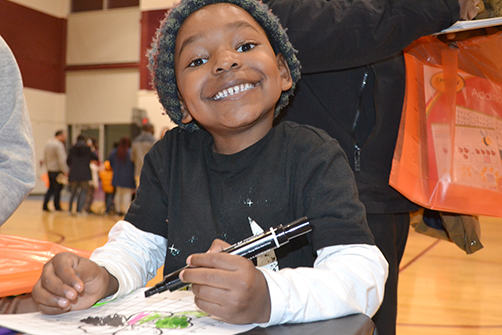
A STEAM night visitor is all smiles while working at the Anamorphic Art Station.
Over the last several years, the familiar acronym, STEM (science, technology, engineering, and mathematics) has improved its reach by incorporating a seemingly disparate but actually complementary discipline: Art. That’s what the recent March 5th STEAM Night at the Dr. Martin Luther King, Jr. Elementary School in Urbana was all about—exposing kids, especially minority students, to STEM via some element of art.
In addition to the school's night featuring STEAM, several other acronyms —outreach-minded University student groups—partnered with the school to help make the night possible. For instance, the event was organized by GEDI (Graduate Engineers Diversifying Illinois), a brand new organization that hopes to foster diversity in STEM. The group was recently begun by Electrical and Computer Engineering (ECE) PhD student Lonna Edwards, a long-time outreach enthusiast who got her start helping ECE Professor Lynford Goddard with his GLEE GAMES camp. Edwards was also responsible for organizing the STEAM Night.
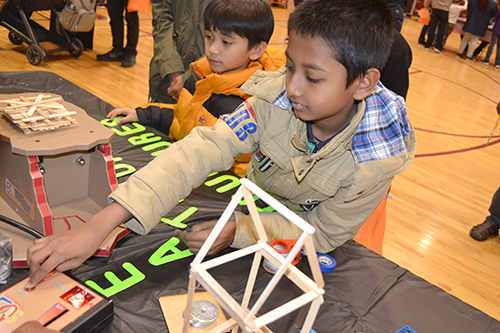
A STEAM night visitor ratchets up the shaking while testing the earthquade structure he built.
Also contributing to the event were several members of ENVISION (ENgineers Volunteering In STEM EducatION), a five-year-old student group begun to provide an outreach vehicle for engineering graduate students. The third group who volunteered for the STEAM Night was the UIUC Chapter of the National Society of Black Engineers (NSBE), also dedicated to exposing kids, especially students of color, to STEM. Finally, the fourth partner was Mechanical Science and engineering’s STEM education outreach guru, Joe Muskin, who has never met a STEM outreach event he hasn't liked.
The school gym was filled with stations featuring a variety of different, fun projects for kids to explore. For example, at one earth-shaking, civil-engineering-related hands-on activity, the kids enjoyed designing earthquake-proof structures. At this particular station, youngsters used craft sticks and hot glue to create their structures. Then, as part of the activity, they would test their structures using an instrument that would shake their structure to determine the their design's stability. The instrument’s “shaking” ranged from the equivalent of a small earthquake of around 1.0 to magnitude, up to a 9.0 or even 10.0 on the Richter scale.
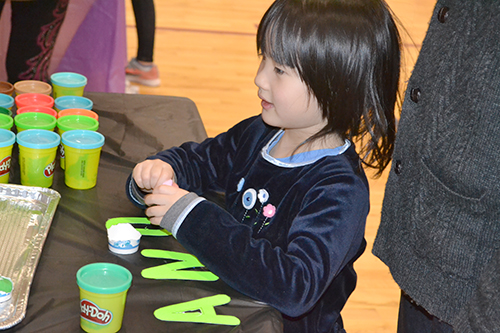 A young visitor at the volcano station shapes her "volcano" out of playdoh.
A young visitor at the volcano station shapes her "volcano" out of playdoh.Kids also had an opportunity to build a “volcano” that actually erupted! In this activity, which was related to chemical and/or materials engineering, kids shaped PlayDoh into a volcano inside a paper cup. Then, in the center of their volcano, they would put some baking soda, then pour in vinegar mixed with food coloring, which made their volcano “erupt” by causing a chemical reaction that produced carbon dioxide and caused the mixture to bubble up and spill over.
Helping out at the volcano station was Paul Ruess, a PhD student in Civil and Environmental Engineering who's studying how food trade causally impacts groundwater depletion. Ruess, who's on the GEDI, ENVISION, and SACNAS list-serves heard about the event from all three.
Ruess says he participated in the STEAM Night because he likes to be involved in his community. For instance, he volunteers routinely with SACNAS's Cena y Ciencias, an after-school Spanish-language program that does science experiments for elementary schoolers, plus he also mentors a student through CU 1-to-1. "This just sounded like another fun and important event," he says.
 Alex Horn and Paul Ruess enjoy helping at the volcano station.
Alex Horn and Paul Ruess enjoy helping at the volcano station.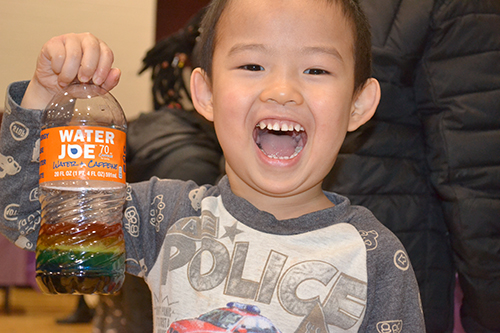 A youngster proudly shows off the Rainbow Jar he made.
A youngster proudly shows off the Rainbow Jar he made.
Ashley Mitchell (left) helps a youngster with their rubberband helicopter.
Ruess shares the impact he believes STEAM Night had on the young participants. "Science is often stiflingly rigid and follows many rules," he explains, "but some of the kids were very creative by making teapot- and even flamingo-shaped volcanos! I hope they can take this creativity with them into STEM fields if they choose to work in those spaces professionally, otherwise we'll have more science-savvy non-scientists which is also extremely valuable. Really I just hope they had fun and felt welcome to explore and be creative participants regardless of their backgrounds and identities, because everybody who wants to participate in STEM has every right to be there."
Another activity related to chemical engineering was the Rainbow Jar, which looked somewhat like a lava lamp, but without bubbles. Kids who participated in this activity poured into their bottle liquids of various densities to which food coloring had been added: corn syrup, dish detergent, olive oil, and honey. They ended up with a bottle filled with stratas of rainbow-colored liquids.
Another popular activity was the Catapult, which kids built using craft sticks, rubber bands, and a plastic spoon. After designing their catapult, which was related to mechanical engineering, kids were invited to test the performance of the device they’d buil. Using it to lob cotton balls at a target, a pyramid of several plastic cups, they learned a bit about physics..
At the Rubber Band Helicopter station, which was related to both mechanical and aerospace engineering as well as physics, young participants had the chance to get creative while creating a helicopter then testing its mobility and speed. Using a variety of materials, including popsicle sticks, paper clips, rubber bands, plastic straws, wood dowels, tape, and wheels and propellers made of plastic, they were to design their copter. A rubber band was then attached to the propeller, which the child wound up tightly, providing the machine's thrust.
Helping out at the helicopter station was Ashley Mitchell, an NSBE member."I got involved with STEAM because I value STEM outreach and enjoy working with kids, especially when it involves STEM-based activities," she reports. "NSBE asked for volunteers to join this event and I was more than happy to help out."
Regarding the benefit of STEAM Night for the kids, Mitchell says, "I think an event like STEAM night really gets kids excited about STEM and builds their curiosity about science." She says another benefit is being exposed to diverse college students. "I think it’s important for them to not only get some hands-on experience with creating something, but interacting with ...college students of color in STEM too."
Another station featured a circuit-building activity which allowed the youngsters to explore some principles related to electrical/computer engineering.
In charge of the Anamorphic Art Station was current ENVISION president, Marley Dewey. At this station, according to Dewey, “Students would transform a picture on a grid to a warped grid and then watch as the picture became un-warped with a mirror (like the reverse of a fun-house mirror). “At the bottom right is an image which shows how it worked.
Dewey reports that Lonna Edwards contacted ENVISION about collaborating on the event. “I thought it would be a fun idea,” she reports, “and we are always looking for more volunteering opportunities.”
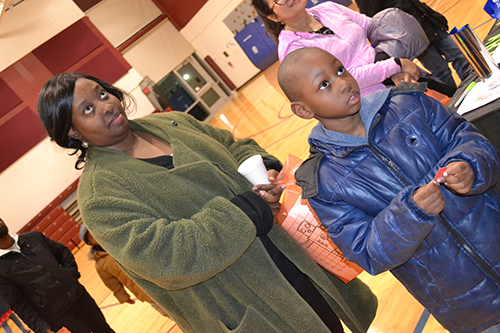
Shamari Graham and her son, John Whittle, wait expectantly to see if his raffle number is called.
 Shenill Hill and her son Journey, who's building a catapult at STEAM Night.
Shenill Hill and her son Journey, who's building a catapult at STEAM Night.Regarding STEAM Night’s impact, Dewey indicates, “I think that the STEAM night, as a whole, made the students more aware of different science principles and STEM fields, such as 3D printing, civil engineering and architecture, and electronics. I hope that it makes them believe that science can be fun!”
In addition to the numerous hands-on activities, several creative STEM toys were raffled off at the end of the night, based on ticket stubs students were given.
Several parents commented on why they had brought their child to STEAM Night. For instance, Shenill Hill brought her son Journey, a 7-year-old who’s in 1st grade at King, for the variety of activities.. Hill, who teaches at the Boy’s and Girl’s club, says, “We have a lot of problems finding STEM activities that are engaging to five, six, and seven-year-olds. And since that’s the particular group that I work with, I wanted to come and see what you guys offer. Because I think it’s really, really important to introduce STEM projects early. Journey told me about this, so as soon as I got off work, we rushed over to be part of it.”
In fact, her son was so excited to attend the STEAM night, that they came to the school a night early because he thought it was the day before the actual event. “So, yeah, he’s been looking forward to it,” she acknowledges, adding that, "Journey’s favorite subject is math, and you know, that’s part of STEM."
What is Hill going to do to keep encouraging her young Boys’ and Girls’ club charges in STEM? “Everything that we pick up here, we’re going to take it over to the club, so that we can show the kids how to do the Catapult, how to do the circuits, and what not, and just kind of help them to expand. So everything that we pick up here, we’re going to share with cousins, with friends, anyone that’s willing to learn.”
Another mother, Shamari Graham, shares why she brought her six-year-old son, John Whittle, who’s a first grader, to STEAM Night. “He loves coming to the activities that they have here at King, I told him it was about how things work, and he loves to do a lot of things at home, so I thought it would be something nice for him to come to experience.”
John reports that his favorite activity of the night was the Catapult. His take on STEAM night? “I liked it. It was so cool. Awesome!”
Author/Photographer: Elizabeth Innes, Communications Specialist, I-STEM Education Initiative
More: ENVISION, Dr. M. L. King Elementary, MechSE, STEAM/SciArt, 2020
For additional I-STEM web articles about Dr. Martin Luter King School, see:
- Paper2Tree Plants Trees, Sows Seeds Regarding Potential Careers in Engineering (2018)
- Mattia Gazzola’s Paper2Tree: A 3-Step Program to Give Back to Your Community: Publish a Paper ➜ Plant a Tree ➜ Perform a School Outreach (2017)
- Grand Opening of Orpheum’s Air Maze Celebrates Fluid Mechanics, Rheology (2015)
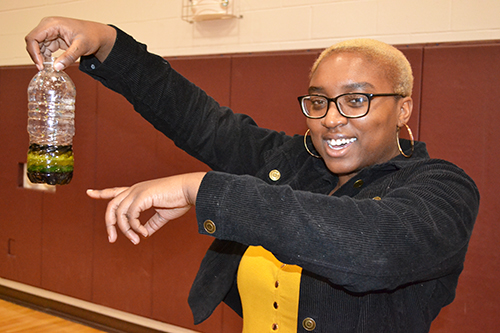
An Illinois student exhibits what the Rainbow Jar station helped the kids make.
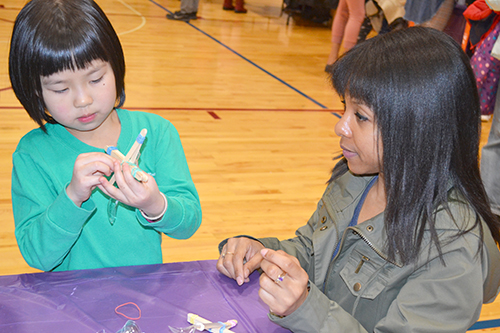 Lonna Edwards (right) helps a student build a catapult.
Lonna Edwards (right) helps a student build a catapult.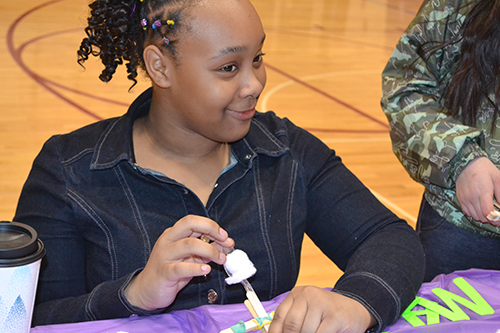
A STEAM Night visitor prepares to lob a cotton ball at the target: a plastic cup pyramid.
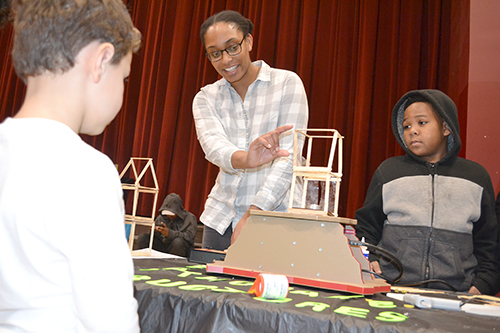
Jamie Clark, a member of the GEDI organization, tests the earthquade structure a young visitor built.
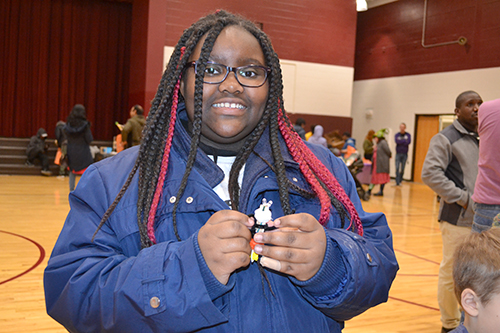
An M. L. King student works on a hands-on activity at the electrical engineering table.
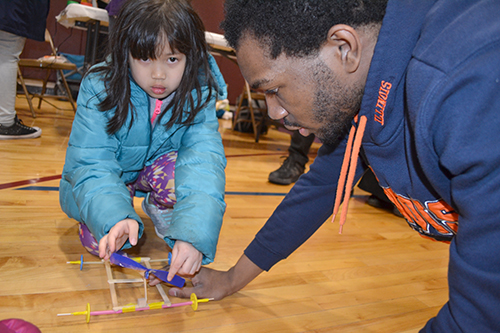
Kingsley Okeke (right), helps a young visitor test her rubberband helicopter.
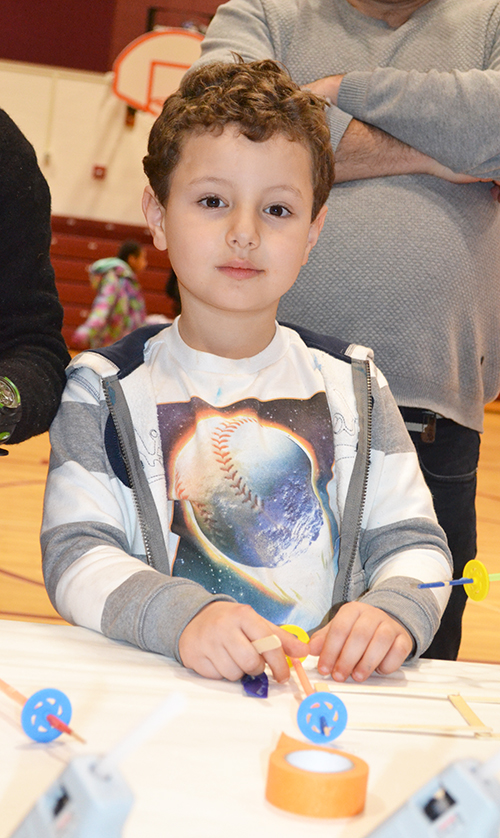 A STEAM Night visitor creates a rubberband helicopter.
A STEAM Night visitor creates a rubberband helicopter.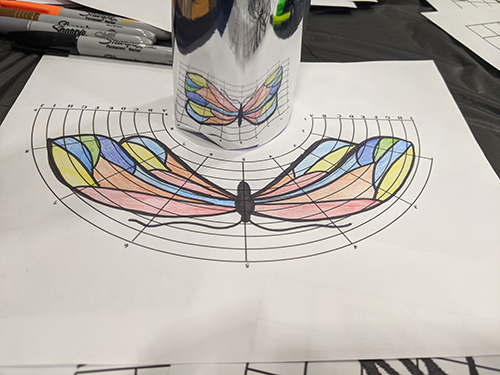 Like the reverse of a fun-house mirror, at the Anamorphic Art Station, participants would transform a picture on a grid to a warped grid and then watch as the picture became un-warped with a mirror. (Image courtesy of Marley Dewey.)
Like the reverse of a fun-house mirror, at the Anamorphic Art Station, participants would transform a picture on a grid to a warped grid and then watch as the picture became un-warped with a mirror. (Image courtesy of Marley Dewey.)












.jpg)
















